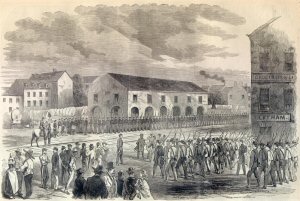|
Third Battle Of Winchester
The Third Battle of Winchester, also known as the Battle of Opequon or Battle of Opequon Creek, was an American Civil War battle fought near Winchester, Virginia, on September 19, 1864. Union Army Major General Philip Sheridan defeated Confederate Army Lieutenant General Jubal Early in one of the largest, bloodiest, and most important battles in the Shenandoah Valley. Among the 5,000 Union casualties were one general killed and three wounded. The casualty rate for the Confederates was high: about 4,000 of 15,500. Two Confederate generals were killed and four were wounded. Participants in the battle included two future presidents of the United States, two future governors of Virginia, a former vice president of the United States, and a colonel whose grandson, George S. Patton, became a famous general in World War II. After learning that a large Confederate force loaned to Early left the area, Sheridan attacked Confederate positions along Opequon Creek near Winchester, Vi ... [...More Info...] [...Related Items...] OR: [Wikipedia] [Google] [Baidu] |
American Civil War
The American Civil War (April 12, 1861May 26, 1865; also known by Names of the American Civil War, other names) was a civil war in the United States between the Union (American Civil War), Union ("the North") and the Confederate States of America, Confederacy ("the South"), which was formed in 1861 by U.S. state, states that had Secession in the United States, seceded from the Union. The Origins of the American Civil War, central conflict leading to war was a dispute over whether Slavery in the United States, slavery should be permitted to expand into the western territories, leading to more slave states, or be prohibited from doing so, which many believed would place slavery on a course of ultimate extinction. Timeline of events leading to the American Civil War, Decades of controversy over slavery came to a head when Abraham Lincoln, who opposed slavery's expansion, won the 1860 presidential election. Seven Southern slave states responded to Lincoln's victory by seceding f ... [...More Info...] [...Related Items...] OR: [Wikipedia] [Google] [Baidu] |
President Of The United States
The president of the United States (POTUS) is the head of state and head of government of the United States. The president directs the Federal government of the United States#Executive branch, executive branch of the Federal government of the United States, federal government and is the Powers of the president of the United States#Commander-in-chief, commander-in-chief of the United States Armed Forces. The power of the presidency has grown since the first president, George Washington, took office in 1789. While presidential power has ebbed and flowed over time, the presidency has played an increasing role in American political life since the beginning of the 20th century, carrying over into the 21st century with some expansions during the presidencies of Presidency of Franklin D. Roosevelt, Franklin D. Roosevelt and Presidency of George W. Bush, George W. Bush. In modern times, the president is one of the world's most powerful political figures and the leader of the world's ... [...More Info...] [...Related Items...] OR: [Wikipedia] [Google] [Baidu] |
Shenandoah Valley
The Shenandoah Valley () is a geographic valley and cultural region of western Virginia and the eastern panhandle of West Virginia in the United States. The Valley is bounded to the east by the Blue Ridge Mountains, to the west by the eastern front of the Ridge-and-Valley Appalachians (excluding Massanutten Mountain), to the north by the Potomac River, to the south by the James River (Virginia), James River, and to the Southwest by the New River Valley. The cultural region covers a larger area that includes all of the Valley plus the Virginia Highlands to the west and the Roanoke Valley to the south. It is physical geography, physiographically located within the Ridge and Valley Province and is a portion of the Great Appalachian Valley. Geography Named for Shenandoah River, the river that stretches much of its length, the Shenandoah Valley encompasses eight counties in Virginia and two counties in West Virginia: *Augusta County, Virginia *Clarke County, Virginia *Frederick ... [...More Info...] [...Related Items...] OR: [Wikipedia] [Google] [Baidu] |
Lieutenant General (CSA)
The general officers of the Confederate States Army (CSA) were the senior military leaders of the Confederate States of America during the American Civil War of 1861–1865. They were often former officers from the United States Army (the regular army) before the Civil War, while others were given the rank based on merit or when necessity demanded. Most Confederate generals needed confirmation from the Confederate States Congress, much like prospective generals in the modern U.S. armed forces. Like all of the Confederacy's military forces, these generals answered to their civilian leadership, in particular Jefferson Davis, the president of the Confederate States of America and therefore commander-in-chief of the military forces of the Confederate States. History Much of the design of the Confederate States Army was based on the structure and customs of the United States Army when the Confederate States Congress established the Confederate States War Department on February 21, ... [...More Info...] [...Related Items...] OR: [Wikipedia] [Google] [Baidu] |
Confederate Army
The Confederate States Army (CSA), also called the Confederate army or the Southern army, was the military land force of the Confederate States of America (commonly referred to as the Confederacy) during the American Civil War (1861–1865), fighting against the United States forces to support the rebellion of the Southern states and uphold and expand the institution of slavery. On February 28, 1861, the Provisional Confederate Congress established a provisional volunteer army and gave control over military operations and authority for mustering state forces and volunteers to the newly chosen Confederate States president, Jefferson Davis (1808–1889). Davis was a graduate of the United States Military Academy, on the Hudson River at West Point, New York, and colonel of a volunteer regiment during the Mexican–American War (1846–1848). He had also been a United States senator from Mississippi and served as U.S. Secretary of War under 14th president Franklin Pierce. ... [...More Info...] [...Related Items...] OR: [Wikipedia] [Google] [Baidu] |
Major General (United States)
In the United States Armed Forces, a major general is a two-star rank, two-star general officer in the United States United States Army, Army, United States Marine Corps, Marine Corps, United States Air Force, Air Force, and United States Space Force, Space Force. A major general ranks above a Brigadier general (United States), brigadier general and below a Lieutenant general (United States), lieutenant general. The U.S. uniformed services pay grades, pay grade of major general is O-8. It is equivalent to the rank of Rear admiral (United States)#Rear admiral, rear admiral in the other United States Uniformed services of the United States, uniformed services which use Naval officer ranks, naval ranks. It is abbreviated as MG in the Army, MajGen in the Marine Corps, and in the Air Force and Space Force. Major general is the highest permanent peacetime rank that can be conferred upon a commissioned officer in the uniformed services (except when General of the Army (United States ... [...More Info...] [...Related Items...] OR: [Wikipedia] [Google] [Baidu] |
Winchester, Virginia, In The American Civil War
The city of Winchester, Virginia, and the surrounding area, were the site of numerous battles during the American Civil War, as contending armies strove to control the lower Shenandoah Valley. Winchester changed hands more often than any other Confederate city. Background John Brown's raid on Harpers Ferry Ties between Winchester and the American Civil War are considered to have begun with the suppression of John Brown's raid in October 1859, in nearby Harpers Ferry, West Virginia, Harpers Ferry. Colonel Lewis Tilghman Moore, of the 31st Virginia Militia of Frederick County, Virginia, Frederick County, assembled 150 militiamen from the Marion Guards, the Morgan Continentals, and the Mount Vernon Riflemen, and moved them on the Winchester and Potomac Railroad to Harpers Ferry, to the east. Ironically, the first death of Brown's raid was Heyward Shepherd, a free black from Winchester who worked for the Baltimore and Ohio Railroad, B&O Railroad; he was buried in Winchester's c ... [...More Info...] [...Related Items...] OR: [Wikipedia] [Google] [Baidu] |
Army Of The Valley
The Army of the Valley (officially the Army of the Valley District) was the name given to the army of Lt. Gen. Jubal Early's independent command during the Shenandoah Valley Campaigns in the summer and autumn of 1864. The Army of the Valley was the last Confederate unit to invade Northern territory, reaching the outskirts of Washington, D.C. The Army became defunct after its decisive defeat at the Battle of Waynesboro, Virginia, on March 2, 1865. History General Robert E. Lee, entrenched at Petersburg, wanted to siphon off some of the overwhelming number of Federal troops that he faced. He was also concerned with recent Union victories in the Shenandoah Valley (a vital source of supplies and food for his army). He devised a daring plan to accomplish both ends. On June 12, 1864, Lee ordered Jubal Early to take independent command of the Army of Northern Virginia's Second Corps, renaming it as the Army of the Valley (the name given to many of these same troops by Stonewall Jack ... [...More Info...] [...Related Items...] OR: [Wikipedia] [Google] [Baidu] |
Army Of West Virginia
The Army of West Virginia served in the Union Army during the American Civil War and was the primary field army of the Department of West Virginia. It campaigned primarily in West Virginia, Southwest Virginia and in the Shenandoah Valley. It is noted for having two future U.S. presidents serve in its ranks: Rutherford B. Hayes and William McKinley, both from the 23rd Ohio Infantry. With fighting in the Valley ended, the Army of West Virginia's designation was discontinued. History Brigadier General George Crook was appointed to command the Department of West Virginia on July 25, 1864. At the time, Crook's field army was named ''Army of the Kanawha''. On August 9, 1864, the field army of the Department of West Virginia was given the title "Army of West Virginia". This "army" would eventually consist of three divisions and for all practical purposes functioned as a corps in Maj. Gen. Philip Sheridan's Army of the Shenandoah. This command has often been referred to as the ''VIII Cor ... [...More Info...] [...Related Items...] OR: [Wikipedia] [Google] [Baidu] |






